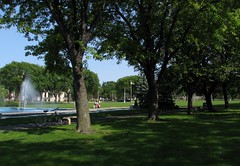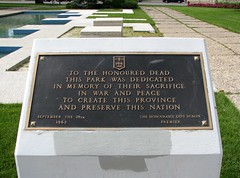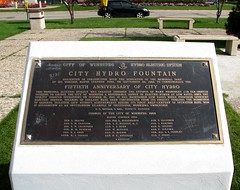Address: Memorial Boulevard between Broadway and York Map
Opened: 1962
Architect: Cameron Man
Cost: $120,000
Background
Opened: 1962
Architect: Cameron Man
Cost: $120,000
Background
The city had long been interested in constructing a mall or grand boulevard stretching from Portage Avenue to the Legislative Building but assembling the assorted plots of land took longer than expected.
One landowner that they had to deal with was the Hudson's Bay Company. In the mid 1920s the two agreed on a land swap that saw the city obtain vacant land near present-day St. Mary Avenue at Memorial Boulevard while the Bay got a parcel of vacant land near Portage and Memorial on which they built their new flagship department store.
Free Press May 21, 1925:
In 1925 the city announced that construction would begin on the first phase of "The Mall" stretching from Portage Avenue to St. Mary Avenue. Soon after it was announced that the Mall would be home of the city's permanent cenotaph, a project that spent years trying to get off the ground.
One landowner that they had to deal with was the Hudson's Bay Company. In the mid 1920s the two agreed on a land swap that saw the city obtain vacant land near present-day St. Mary Avenue at Memorial Boulevard while the Bay got a parcel of vacant land near Portage and Memorial on which they built their new flagship department store.
Free Press May 21, 1925:
In 1925 the city announced that construction would begin on the first phase of "The Mall" stretching from Portage Avenue to St. Mary Avenue. Soon after it was announced that the Mall would be home of the city's permanent cenotaph, a project that spent years trying to get off the ground.
Memorial Boulevard ca. 1954 from winterbos on flickr:
The University of Manitoba campus still occupied the land south of St. Mary Avenue. In the 1950s there was a push to get the university to relocate their remaining downtown facilities to their Fort Garry campus. This left a large parcel of prime land that would be soon up for grabs.
There was talk of constructing new provincial office buildings, creating a sort of "Legislature campus". It was then touted as the home of a new Winnipeg City Hall, the city even purchased the land for this purpose in the late 1950s. Frosty relations between Premier Douglas Campbell and Mayor Stephen Juba scuttled those plans.
Free Press Oct 16, 1961
In 1961 the province announced the creation of a provincial park on the site. On April 28, 1961 a 'handing over' ceremony took place where Juba turned over the deed for the 4.5 acres of land to the province and in return Roblin gave Juba a cheque to cover the original purchase price and cost of construction.
As the site was already home to the cenotaph at one end and the "Next of Kin" Monument at the other, it was decided that the extended Mall would be dedicated to Veterans. Roblin said that the park "...should be one of the most beautiful in Canada and a fitting tribute to those who gave their lives for Freedom" (Winnipeg Free Press, October 10, 1961)
The plans included the extension of the roadway to the front of the Legislature and making York Avenue an east - west though street. The roadwork was completed in November 1961. The area immediately north of York would be the actual park space with 126 trees, a reflecting pool, a fountain and flower gardens.
Free Press October 10, 1961:
The centerpiece of the park is the pool and fountain. Construction on the 120' x 100' pool began in September 1961. The 'dancing fountain' with coloured light display and jets powerful enough to send water 30 feet in the air was supplied by City Hydro to commemorate their 50th anniversary in 1961. For that reason it is simply called 'City Hydro Fountain'.
Winnipeg Tribune, September 18, 1962:
On September 28th, 1962 the park was dedicated by Lieutenant Governor Errick Willis and Premier Duff Roblin. The ceremony was attended by legion officials, war mothers who lost their sons in battle and high school students from across the city. Due to winds gusting to 30 mph the fountain was turned on for only a few moments and the jets were not used at full power.
In 1973 the park was the scene of one of Manitoba's oddest political debates.
The province had approved the construction of a washroom facility on the site. Juba did not like the idea and went on a public campaign against minister Russ Doern and the washrooms. The city refused to issue a building permit and the debate reached a climax when Juba had a 'port-a-potty' placed on the site with a sign declaring it to be the new office of the minister.
In the end, the Province built the 'Broadway Biffy' which was demolished in 2006.
Dedication plaques for City Hydro Fountain










Great write up. Just one note – Making a Place: A History of Landscape Architects and Landscape Architecture in Manitoba has a fairly detailed account which lists Cameron Man as the architect for the fountain. Apparently its construction was made more difficult due to the remains of a manure yard and Colony Creek on the site. This meant that most of the money was sunk into preparation, meaning the initially planned vertical elements and limestone were not affordable. The fountain is still a lovely place to wile away some time during the summer, regardless.
ReplyDeleteAn interesting history.
ReplyDeleteRussell Doern was not premier, though. He did write a memoir of the Schreyer administration, "Wednesdays are Cabinet Days."
And wasn't Steve Juba Stephen, not Steven?
Thanks. Corrections made !
ReplyDelete